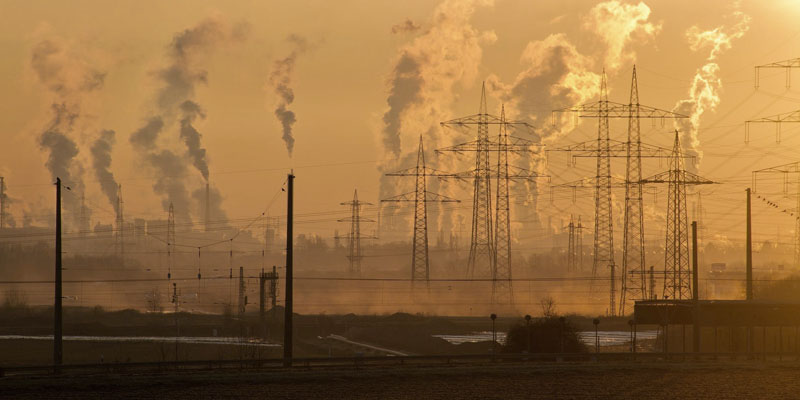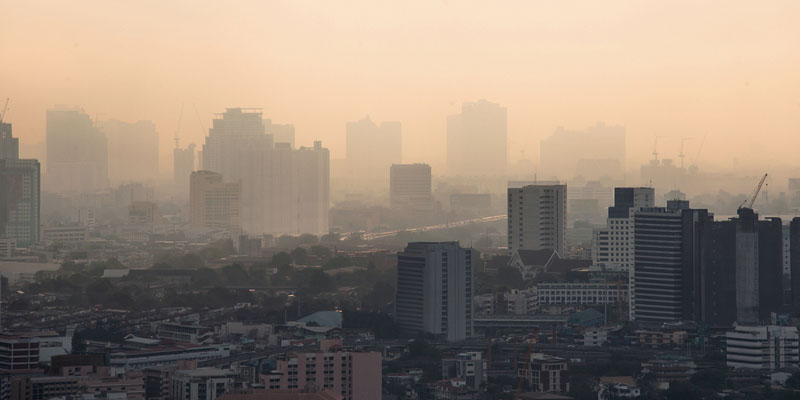We explain what atmospheric pollution is, and explore its effects. In addition, we discuss its characteristics and possible solutions.

What is atmospheric pollution?
Atmospheric pollution is a global environmental issue caused by the emission of toxic substances into the atmosphere, leading to harmful effects on human health, ecosystems, and climate. The primary sources of air pollutants are fossil fuels, industrial activity, transportation, and energy production.
The main effect of atmospheric pollution is climate change. Most of the gases emitted by human activities are greenhouse gases (GHGs), which increase the atmosphere's capacity to retain heat, causing a progressive rise in Earth's temperature. This temperature increase contributes to the intensification of extreme weather events such as droughts, storms, and hurricanes.
Atmospheric pollution intensified following the Industrial Revolution, which began in the 18th century. Over time, this problem has worsened to such an extent that in many cities, air pollution levels are well above the maximum safe quality indexes and are harmful to health.
- See also: Environmental pollution
Types of atmospheric pollutants

Depending on how they enter the atmosphere, atmospheric pollutants can be classified into:
- Primary pollutants. These pollutants are emitted directly into the atmosphere, as is the case with vehicle exhaust gases and factory emissions.
- Secondary pollutants. These substances are not harmful in themselves but become toxic when a chemical reaction occurs with other substances in the atmosphere, like nitrogen dioxide.
Depending on their composition, two types of atmospheric pollutants can be identified:
- Gases. Various gaseous or vapor-phase pollutants rise into the atmosphere as they are less dense than air, exerting a harmful effect. Carbon dioxide, carbon monoxide, nitrogen oxides, and gases resulting from the burning of hydrocarbons (fossil fuels including gasoline, diesel, and coal) are examples of gaseous pollutants.
- Aerosols. These are heterogeneous mixtures of solid or liquid particles suspended in a gas. These particles may be inhaled and enter the bloodstream, potentially causing various health disorders. Aerosols are mainly produced by the burning of fossil fuels and industries.
Gaseous pollutants

The main gaseous pollutants emitted into the atmosphere are:
- Chlorofluorocarbon (CFC). This gas is used in the refrigeration and air conditioning industry. Its emission has virtually stopped because of its proven ozone layer depletion effects.
- Carbon monoxide (CO). This gas is primarily emitted by the incomplete combustion of fuels in vehicles and heating equipment. It is extremely dangerous for animals and humans.
- Carbon dioxide (CO2). This gas is naturally present in the atmosphere. However, its concentration has increased due to the burning of fossil fuels like oil, natural gas, and coal. It is one of the main greenhouse gases (GHGs) emitted into the atmosphere.
- Nitrogen oxide (NO). This gas is emitted mainly by vehicles, power plants, and industries. It contributes to the formation of smog and acid rain.
- Sulfur dioxide (SO2). Like in the previous case, this gas is produced during the combustion of sulfur-containing coal, generating sulfuric acid in the atmosphere, which is detrimental to plant and animal life.
- Methane (CH4). A major greenhouse gas, it is produced by the decomposition of organic matter. Animal feces and the accumulation of organic waste are the main sources of this gas emissions.
Effects of atmospheric pollution
The main effects of atmospheric pollution are:
- Deterioration of air quality. The worsening of air quality leads to an increase in respiratory diseases, weakening of the immune system, and potential complications arising from the presence of heavy metals and harmful substances in the human body.
- Smog formation. Smog refers to pollutants suspended in the air that often form gray clouds lingering over cities for long periods of time. It occurs mainly in large cities with high levels of traffic and industrial activity.
- Climate change. Climate change is made evident in the rise of the planet's global temperature and the intensification of extreme weather events such as droughts, heat waves, storms, and hurricanes.
- Ozone layer depletion. It is a layer of gas in the atmosphere containing high concentrations of ozone. The ozone layer is important because it acts as a protective shield for the Earth from the sun's ultraviolet radiation. This radiation may weaken the immune system and cause cancer in humans.
Health risks

The main health problems associated with exposure to environmental pollution for extended periods are:
- Respiratory problems. Exposure to pollution can cause asthma, chronic bronchitis, and other respiratory diseases.
- Cardiovascular diseases. Exposure to air pollution has been linked to an increased risk of heart disease, stroke, and cardiovascular disease.
- Cancer. Prolonged exposure to pollution can increase the risk of developing lung, skin, bladder, and other types of cancer.
- Neurological disorders. Exposure to environmental pollutants like lead and mercury can damage the central nervous system and cause all types of neurological problems.
- Decreased fertility. Exposure to pollution can affect fertility in both men and women and increase the risk of miscarriage.
- Genetic malformations. Exposure to pollution can damage genetic material, causing malformations.
Cities with high atmospheric pollution
The cities with the highest levels of atmospheric pollution on the planet are those with the highest volume of vehicle traffic, industrial activity, and the fewest government controls.
Among the cities with the worst air quality levels are:
- Delhi (India)
- Lahore (Pakistan)
- Johannesburg (South Africa)
- Jakarta (Indonesia)
- Dhaka (Bangladesh)
- Santiago (Chile)
- Karachi (Pakistan)
- Kathmandu (Nepal)
- Bombay (India)
- Beijing (China)
Possible solutions to air pollution

Some of the strategies proposed by environmental pollution experts to improve living conditions on the planet include:
- Promote the use of renewable energies. Energies like solar or wind power can help reduce atmospheric pollution levels.
- Support energy efficiency. Investing in sustainable industrial technologies can contribute to reducing the emission of gaseous pollutants generated from energy and fuel production.
- Implement adequate waste management measures. Improving waste management can help reduce the amount of waste and minimize its impact.
- Promote environmental education. Educational practices focused on environmental education contribute to raising awareness of the importance of environmental care in the public and private spheres.
- Stimulate research. The development of cleaner technologies for industries and vehicles can help improve the planet's environmental conditions.
- Reduce the use of private cars. Encouraging the use of public transportation and non-polluting vehicles such as bicycles helps reduce the emissions of gaseous pollutants into the atmosphere.
International protocols
Several international environmental protocols are in force worldwide. Among the most important are:
- Montreal Protocol. An international treaty aimed at protecting the ozone layer by gradually eliminating the production and consumption of ozone-depleting substances like chlorofluorocarbons (CFCs). It has been in force since 1989.
- Kyoto Protocol. An international agreement to combat climate change by establishing targets for reducing greenhouse gas (GHG) emissions. It has been in effect since 1997.
- Stockholm Convention. An international agreement to protect human health and the environment from persistent organic pollutants (POPs). It has been in force since 2004.
- Paris Agreement. An international agreement to limit global warming to less than 2 degrees Celsius above pre-industrial levels by reducing greenhouse gas emissions. It has been in effect since 2015.
Explore next:
References
- Academia Mexicana de Ciencias (2007) Los efectos de la contaminación ambiental sobre nuestra salud. https://www.amc.edu.mx/
- Ambientum (2022) Los contaminantes atmosféricos. https://www.ambientum.com/
- CEPAL (s.f) El Protocolo de Montreal relativo a las sustancias que agotan la capa de ozono. https://observatoriop10.cepal.org/
- IQAir (2023) Ranking de las ciudades de calidad de aire y contaminación. https://www.iqair.com/
- Naciones Unidas (s.f) ¿Qué es el acuerdo de París? https://unfccc.int/
Was this information useful to you?
Yes NoThank you for visiting us :)